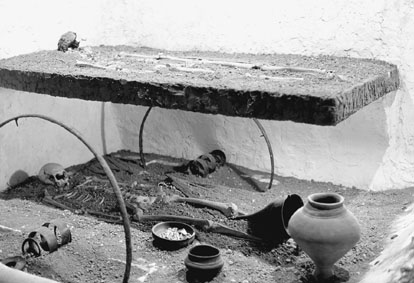

 | Page 786 |  |
does not explain the lack of care taken while doing it. Many of the archaeologists who participated in the site’s “exploitation” were much more conscientious elsewhere. These archaeologists probably tolerated the looting of the La Tène site by many collectors because they judged it too late to carry out any serious archaeological work there, owing to technical difficulties. It is certain that the relative typological homogeneity of the material tempered their scientific fervor by taking away a good part of what generally motivated stratigraphic observations.

Reconstruction of a grave found in France, La Tène period
(The Art Archive/Musée des Antiquités St. Germain en Laye/Dagli Orti)
They also recognized that important reshapings of the strand at the head of the lake, which is often marked by violent storms, had drastically changed the terrain so that artifact position would have seemed of little significance. And last but not least, the considerable extension of the site, together with the absence of practical landmarks, might have made attempts of planimetric documentation seem useless. In the accounts of the excavations, archaeologists, once their booty was listed, endeavored to justify their scientific carelessness by the devastated condition of the site around the area of their findings. These important finds were dispersed into many private collections, and they can be found in museums all over the world. There is no complete inventory of the artifacts.
When professional excavations began at La Tène in 1907, the site was considered to be almost exhausted. Local authorities created the Societe d’Histoire et d’Archeologie de Neuchâtel and granted it financial support to undertake new excavations. The society gave the Commission des Fouilles de La Tène full responsibility for the work. Excavations, supervised by William Wavre and then Paul Vouga (famous for his work on lakeshore Neolithic), lasted until 1917. Vouga’s systematic excavations, as well as his attempts to understand former work, resulted in the following picture.
The two bridges are set more than 100 meters apart, and a fence runs alongside the bank, probably to strengthen it. To the south, there were some buildings, whose plans are not clear,
 |  |